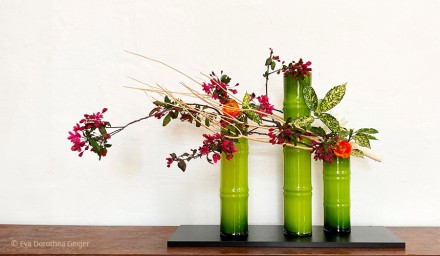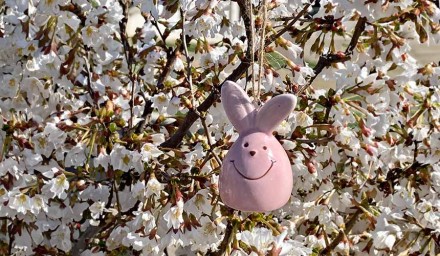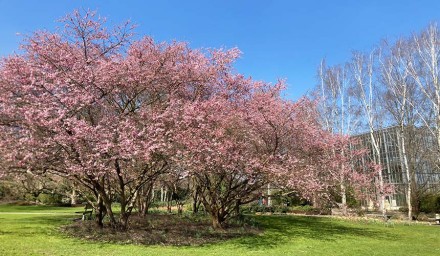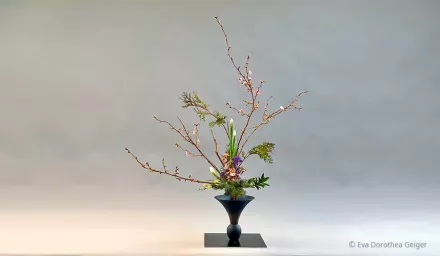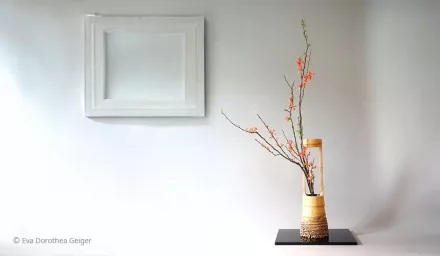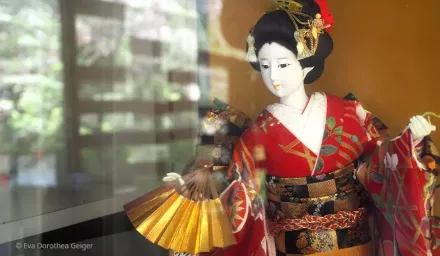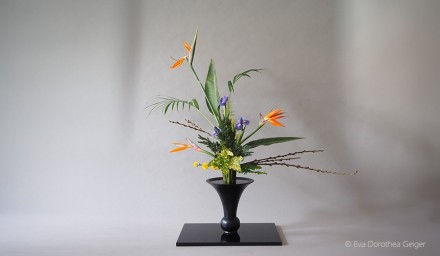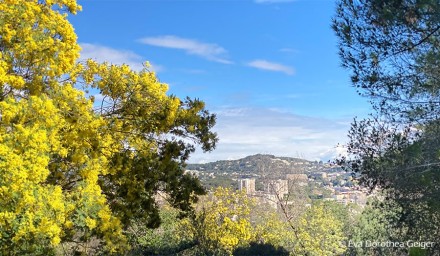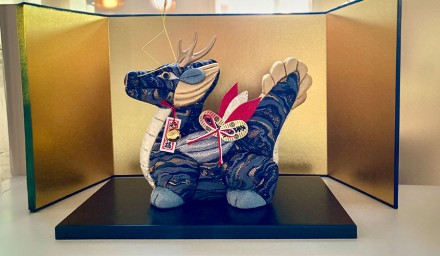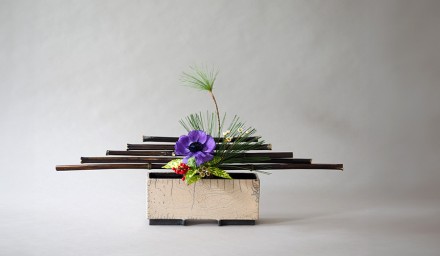ichi-go ichi-e / Ikebana in Marwitz
Happy Easter
Gentle splendor of blossoms,
Birds singing in the morning light,
Resurrection day.
(Haiku by Eva D. Geiger)
In the days of spring, when the air is filled with a breath of renewal, two symbols of beauty and new beginnings merge: Easter and cherry blossoms. Easter, a celebration of resurrection and reawakening, meets the delicate blossoms of the cherry trees, which bloom in full splendor to herald the arrival of the warmer season.
Hanami
Every spring, when the cherry trees are in full bloom, people from all over the world flock to Japan's famous cherry blossom locations to experience the breathtaking spectacle of the pink blossoms and celebrate the hanami 花見, "blossom viewing". The cherry blossom front begins between the end of March in Kyushu and moves northeast until it arrives in Hokkaido in early May.
Mono no aware oder ‚The fleetingness of life‘
The Japanese cherry / Prunus 染井吉野, also known as Sakura 桜, is one of the most well-known and revered flowers in Japan and has a deep cultural and symbolic meaning.
The cherry blossom heralds the warm part of the year and is not only a sign of spring, but also a symbol of new beginnings, beauty and transience. A symbol of feminine beauty in Japan, its short flowering period of just one to two weeks reminds people to appreciate the beauty of the moment and enjoy life.
Flowering quince branches
The ornamental quince (bot. Chaenomeles) belongs to the rose family (Rosaceae). This plant genus is native to East Asia (Japan, China, Myanmar) and comprises five species. Their flowers are white, salmon-coloured or even red and have a wonderful fragrance. They enrich any garden or park, especially in spring, giving it an Asian ambience. The striking flowers attract bees in particular, but the fruits that appear later are also edible. Quince is one of the most popular ornamental shrubs in gardens and parks.
Hina matsuri
hina-matsuri, also known as the Japanese Girls' Festival or Doll Festival, is a traditional holiday in Japan that is celebrated every year on 3 March. The festival has a long history dating back to the Edo period and has deep cultural significance for the Japanese. The festival is an opportunity to celebrate and wish for the health and happiness of girls.
Strelitzia
The bird of paradise flower is a fascinating plant that makes a real statement with its vibrant flowers and exotic shapes, and not just in the Rikka Shōfūtai. It belongs to the Strelitziaceae family and originally comes from the humid tropical regions of Africa.
Blue sea and yellow sea of flowers
If you are longing for warmth, the sea and a spring awakening after the dark and cold winter months here, then the time is ripe for the Côte d'Azur. After the mild winters, in spring on the Côte d'Azur nature comes to life along the coast and a variety of flowers begin to bloom to fill the landscape with color and fragrance.
One of the most notable blooms is the mimosa, which adorns the hills and valleys of the region with bright yellow flowers in February and March. Their sweet fragrance and radiant color transform the landscape into a true paradise.
Tatsu-doshi / The Dragon Year
The Year of the Dragon, known as tatsu-doshi in Japan, is an outstanding event in the Chinese zodiac that is also significant in Japanese culture. According to the Chinese zodiac, the Year of the Dragon repeats every twelve years. For example, the last Years of the Dragon were 2012, 2000, 1988, etc., and now the Year of the Dragon begins again on February 10, 2024. Each year, one of the four elements is assigned to the sign of the zodiac, which influences fate in a decisive way. This year it is the element wood.
Tags
First arrangement of the year
The hatsu-ike 初生け, the first arrangement of the year, which is made up of the characters hatsu 初 (the first) and 生け (Ike) from the term ikebana, stands for the first ikebana of the year. It is not just a ritual, but also celebrates new beginnings and the art of living in harmony with nature. In the spirit of hatsu-ike, kadokas create special arrangements to mark the transition into the new year. This practice is a symbolic gesture for renewal and reflects the hopes and aspirations for the coming year.
